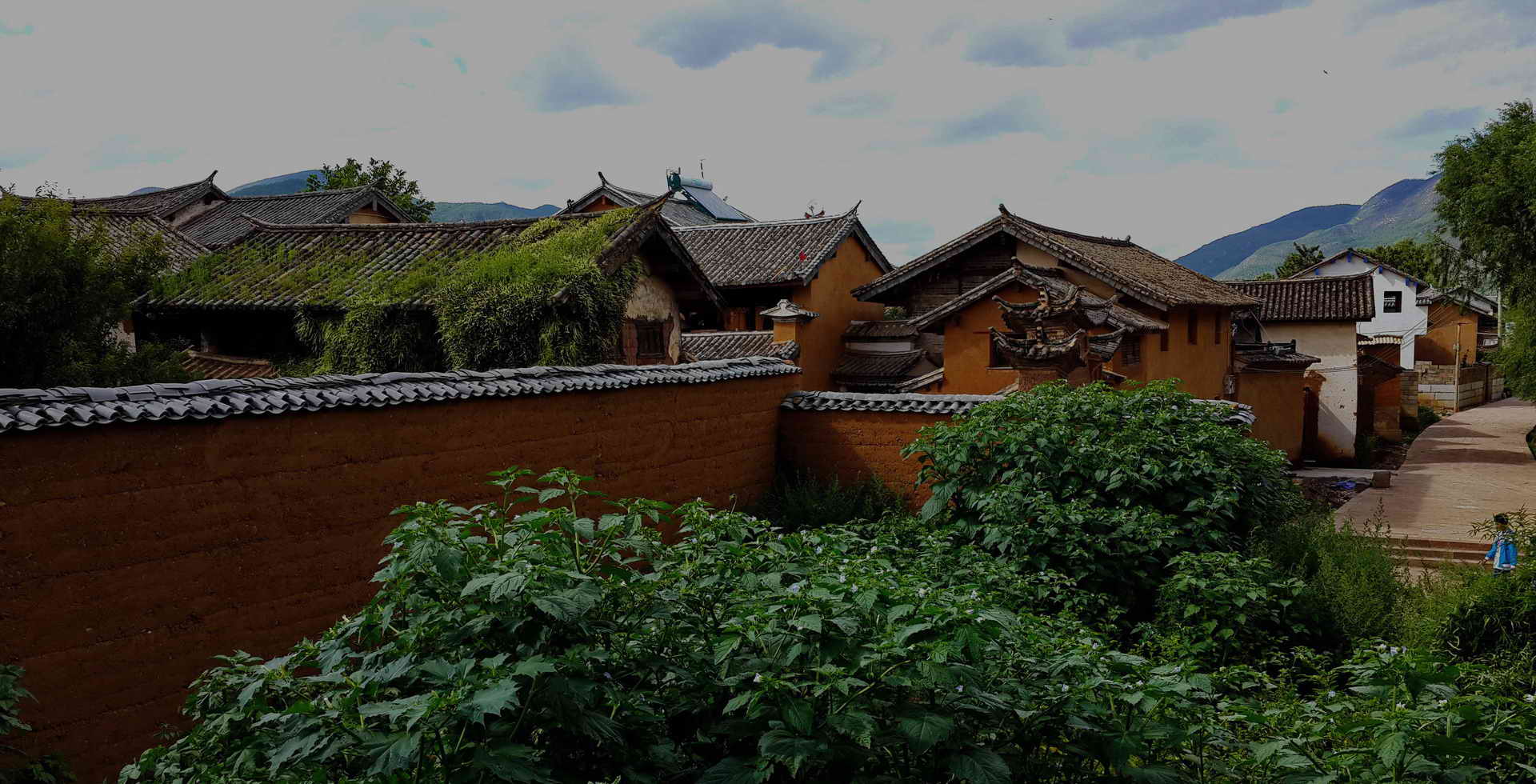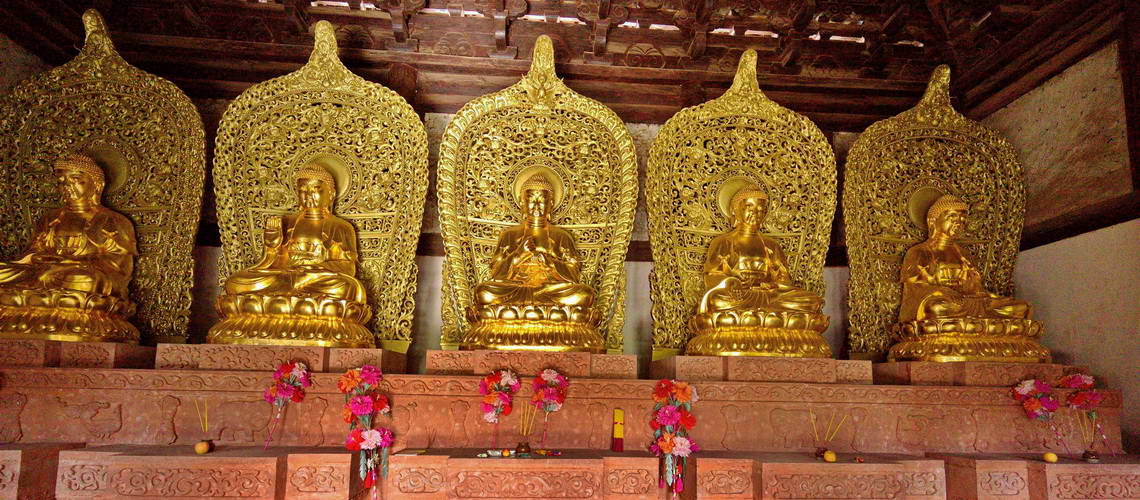
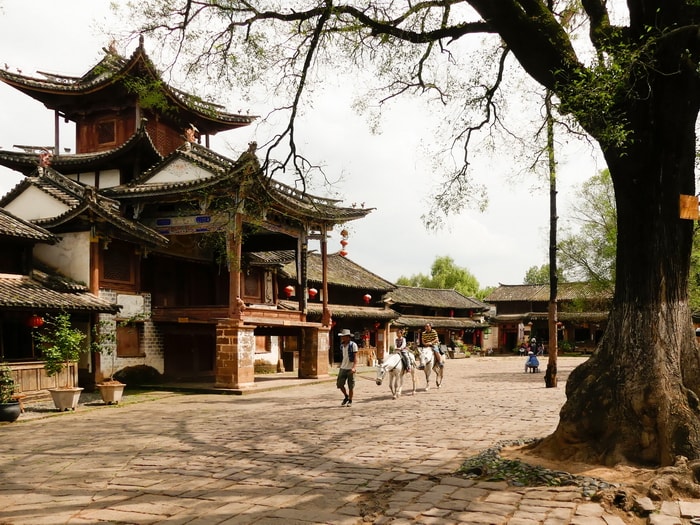
茶马古道上的十字路口
在如今这个远途航班和高速列车充斥的年代,很难想象,将沙溪与外界连接起来的第一条柏油公路竟是在2009年才建成。在如今的沙溪,很多地方仍在使用红砂石或鹅卵石铺成的古老道路,但寺登村新修建的道路极大的缓解了交通不便的情况。这里如同一扇时光的窗,轻轻推开,便可以瞥见极其罕见的古老中国的南方小镇。
百年老剧场主统治着广场,尽管与段家登的戏台会馆的邻居不同,它很少开放给 访客。 古镇的小巷错综复杂,曾几何时,满载货品的马帮在这里穿行,铃声阵阵。时光飞逝,如今则是游客在这醉人的迷宫里穿梭、探寻。
广场上没有丽江那样无穷无尽的旅行团,清晨或傍晚是欣赏这里的最佳时间。日出时分,这里是最佳的太极拳练习场地;而日暮西垂之际,则最适合寻求创作的灵感。
Recommendations
白族人家的院落,精美华丽的大门,仍然遵从旧制,历经很多个世纪而几乎未曾改变。一些曾经的铁匠铺和商人驿站如今已被改建为客栈或是纪念品商店,而其他的大部分建筑仍然保持着其最传统的功能。
这里的小广场一度被用作集市贸易,每天都熙熙攘攘,车水马龙。如今,集市已经转移到了镇上的其他地方,但那些久远的痕迹,仍然吸引着徒步者、历史爱好者和热衷于环保的旅行者。在上个世纪,对于生活于繁华都市的人们来说,沙溪寺登村还是一个难以到达的偏僻小镇,但是这个国家级的地标单位正在复兴,并将会成为整个云南最具吸引力的景点之一。
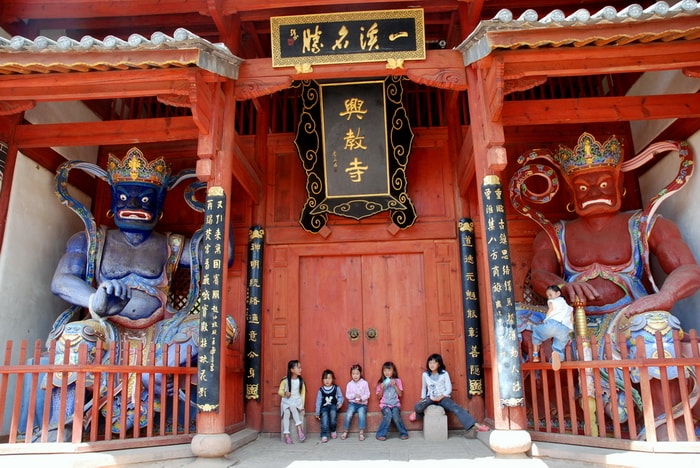
兴教寺建于明永乐十三年,即公元1415年,已有超过600年的历史。它是我国目前保存规模最大、最典型、最有代表性的佛教密宗“阿吒力”寺院。兴教寺内保存有明代佛教壁画,其题材广泛,人物众多,造型生动,形象逼真,线条流畅,色彩绚丽,溶佛教故事与世俗生活为一体,颇具民族风格。大殿内出自沙溪甸头村古代白族画匠张宝之手的多幅明代壁画非常珍贵,其中《太子游苑图》等,生动的描绘出了古南诏、大理国的宫廷生活。 兴教寺大殿的建筑结构极具特点:南北顺深长18米,东西进深14.5米,高19米。梁柱肥硕,雄浑凝重。12根立柱微微倾斜,中间用两架过梁、穿枋支撑屋顶,建筑物的重力被合理地分解到了斗拱和立柱墙体上,形成大殿如此巨大开阔的空间,而中间没有一根柱子。这样的建筑结构使得兴教寺抗震性能极强,历经 600年间多次地震,它巍然屹立,丝毫没有变形。这些建筑的梁柱衔接手法精巧复杂,做工大气,既保留了宋、元时期的古建筑大殿式样遗风,又深受白族建筑风格和藏密寺院建筑风范的影响,属国内罕见。 也许是上天的眷顾,在文化大革命期间,兴教寺被当地政府征用,从而避免了遭到破坏,被完好的保存了下来。
沙溪修复项目组通过辛苦的修缮工作,使得这里成为茶马古道游览路线中不得不看的一处胜景。珍贵的药用植物在幽静的庭院中生长,纯净的自然环境护卫着这里远离喧嚣。天王殿的墙壁上仍然能够看到时光的印记,大殿天顶上的斗拱结构繁复到令人惊叹,在大殿的内部,五座金佛安详的坐在有着华美雕刻的宝座之上。 在兴教寺的院落中,展示有沙溪修复项目对于沙溪的长期改善计划,以及著名的英国艺术家卡洛琳弗朗西斯国王非常详细的植物插图,和本地多彩的药用植物。 寺庙的正对面是令人印象深刻的露天戏台,天花板上绘有精美的龙凤图案。顶层是“魁星”神社,人们相信“魁星”是掌管文运的神祗,他能保佑人们学业有成、金榜题名,虽然相比在段家登戏台稍小一点,但仍足以展示当地人民卓越的雕刻技巧。
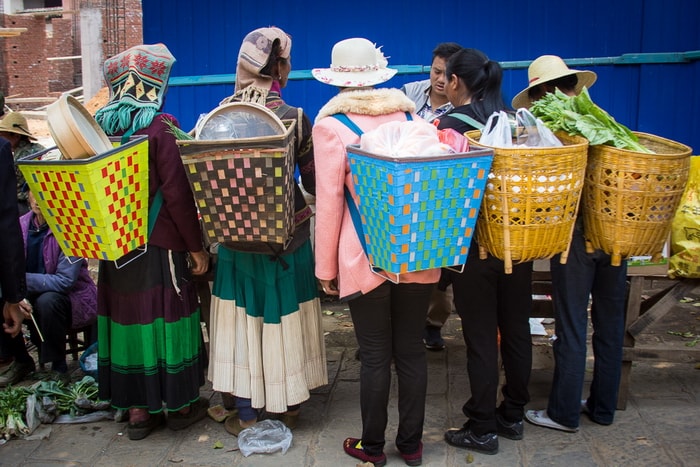
周五的集市是不得不看的重头戏,届时大家都带着各种货品聚集到古镇,或是做些买卖,或干脆只是聚在一起闲聊。身着传统的白族服饰的妇人们在道路旁排成长长的一排,售卖着自己家里种植的各色本地蔬菜。彝族妇女身着黑色白色和红色条纹的大摆裙,上衣通常是白色配黑色或绿色,永远都是非常显眼的风景,她们通常要走数个小时的山路,赶到这里来做物品交易。这恰恰早就了沙溪周五市场的绝佳画面感。
街道的左边是肉类市场,在这里你不光可以买到新鲜的肉食,还可以找到新鲜的山羊奶酪,匠人手工打造的牛铃铛、马具。在市场的右手边你可以看到一排排的本地特色蔬菜和水果,泽芹、莲子、木瓜、释迦果,因有尽有。流动商贩带着各种农具或是果树苗,填满了整个市场。噢,别忘了去看看牲畜交易市场,那里有小猪,羔羊,甚至是水牛在出售。
For more information, contact Sam at Old Theatre Inn.
Insider's Tours
For those coming from Baisha, Lijiang or Shuhe, we recommend Insiders Experience to bring you down to Shaxi by vintage vehicle and see the area in a totally unique way.
From Insider's website: Your
Insider will meet you at your hotel before you hop into one of our vintage jeeps and start cruising local roads crossing the outskirts of the Jade Dragon Snow Mountain. Pause for panoramic views
of the Yangtze River and the surrounding mountain ranges from the Temple of the Clouds. Further down the road to Shaxi traffic has come to a standstill near Jiuhe village as locals have set up a
roadside market providing great photo opportunities (weekends only).
Nowadays it remains rather peaceful on the cobbled streets of Shaxi but during the heydays of the Old Tea Horse Road the place was teeming with life. If today coincides with a Friday, you are in for a treat. On this day the town awakes from hibernation as neighboring Yi and Bai minorities come to sell and buy their produce: women still dress in their colorful traditional outfits and men will often lead pack mules carrying supplies back to their villages in the mountains, just as in the heydays of the old tea horse road. Visit Shibaoshan with its multi- religious shrines prior to taking the newly built highway back to Baisha; your Insider will drop you off at your hotel in Baisha, Shuhe or Lijiang after.
For more information on Insiders tours of Shaxi Friday Market, please contact them directly here.
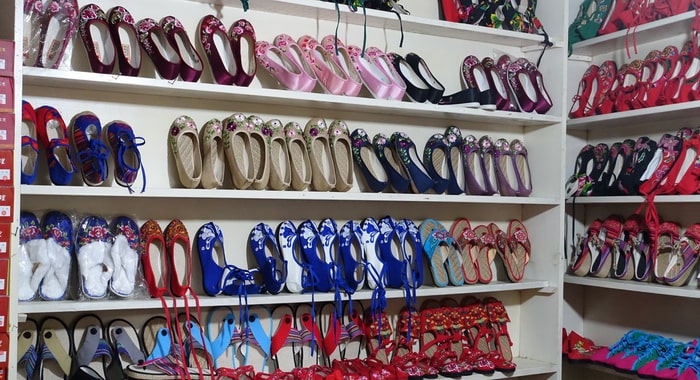
Zhao family handmade shoes
If you're looking for Shaxi handicrafts, start in old town at the Zhao family shoemaker shop. These are finely embroidered silk and cotton shoes still worn for traditional dance and ceremonies in Shaxi. The handmade shoes are reasonably priced and can also be made to order. Find the Zhao family shoes halfway down the main street in Shaxi old town on the left side. In addition to shoes, the Zhao's also make a number of other Shaxi handicrafts such as children's toys and decorative wall hangings.
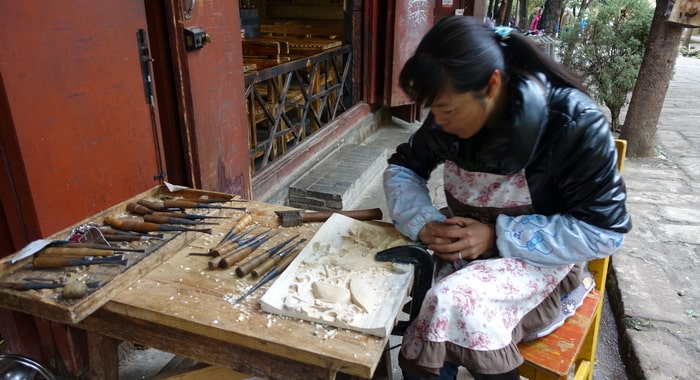
Traditional woodcarving
The Yang family offer Shaxi woodcarving gifts in Shaxi old town. You can often find Mrs. Yang in the process of making these woodcarvings outside her shop. These consist of small lacquered panels for framing, statues of gods and heroes, and other small decorative itmes. These traditional Shaxi woodcarving pieces make very nice gifts and are easy to pack and take home with you.

Xiao Cai handmade jewelry
Xiao Cai is a young woman from Northeast China who settled in Shaxi several years ago. Since then, she has been making beautiful original jewlery in her Sideng Square shop. In addition to jewelry,
she also sells handmade clothing and vintage fabrics.
FIND HER: Facing the old theatre temple in Sideng Square, the jewelry shop is over your right shoulder, on the South corner of the square
before Woodfish restaurant and South Tibet Alley.
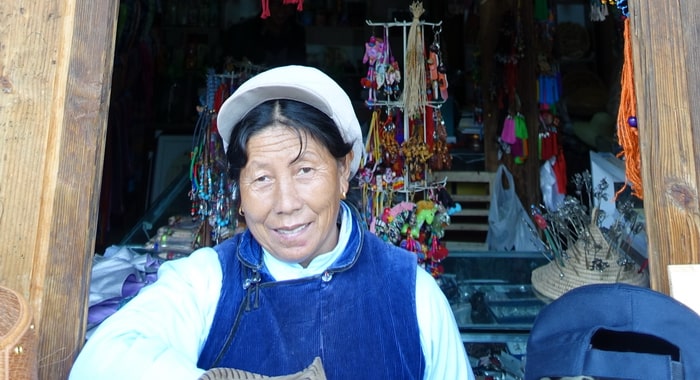
Traditional handicrafts
Located next to the theatre stage in Sideng Square is a great Shaxi handicraft shop with a wide selection of authentic handmade gifts. The shop is run by the local Zhao family who have resisted renting
out for a higher price to non-local Chinese and they are one of the few Shaxi handicraft shops in the old town.
FIND IT: Facing the old theatre temple in Sideng Square, the handicraft shop
is immediately on the left, before Horsepen 46 hostel.
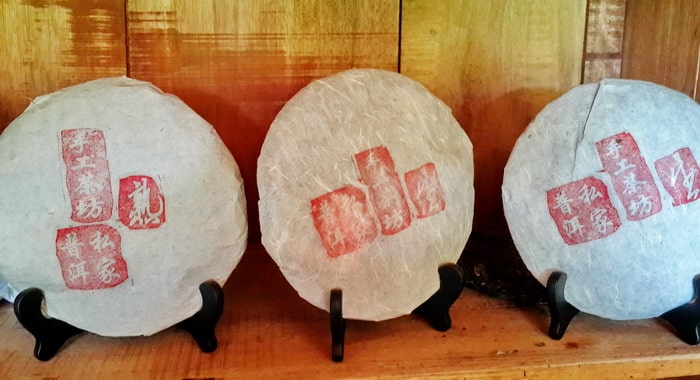
Handmade teas
Ah Ping is a young man from the town of Bao Shan, a tea making district in Eastern Yunnan. Working 11 years in a tea factory there, Ah Ping learned much about the art of Yunnan Puer tea making. He
has set up a shop in Shaxi Old Town where he demonstrates the ancient art of hand pressing Yunnan Puer tea. His shop is intimate and he has a tasting room upstairs. Visitors can choose from various
sizes and varieties of Yunnan Puer tea cakes, some shaped like mushrooms and bells. Yunnan Puer tea makes a great gift for tea lovers, and there's no better place to buy freshly pressed cakes
than Ah Ping's shop.
FIND IT: His shop is located just to the left of Shaxi Xing Jiao temple in Sideng Square.

The meandering Heihui River runs through Shaxi from north to south. Opposite the East Gate of Shaxi Old Town spans the ancient Yujin stone arch bridge. Yujin Bridge was built in the Qing Dynasty during the reign of Emperor Kangxi (1654-1722). For centuries the bridge brought horse caravans over the river to and from Eryuan and Dali. Ensuing years of civil war and neglect took their toll on the bridge which collapsed in the 1920s. In 1931, Jianchuan County held public fundraising to rebuild the iconic bridge, and famous Bai scholar Zhao Fan campaigned personally for "bridge repair offerings". Yujin Bridge arch spans 12 meters, 6 meters high, 5 meters wide, with stone pillars and stone ramparts. There is a stone turtle head vault, and a giant salamander stone. The ancient bridge is a living monument to generations of Shaxi people who have relied on it to bring their produce to market and tend their fields.
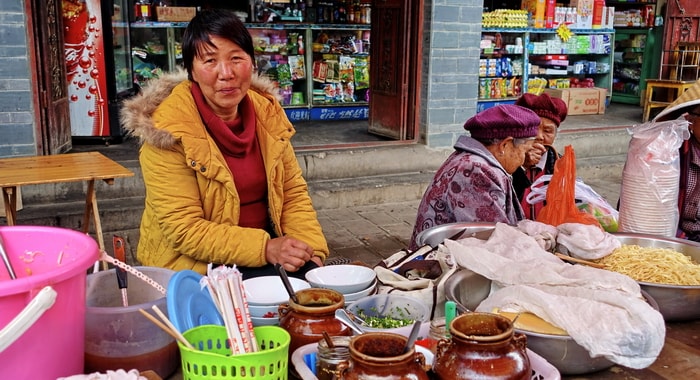
While in town, you will find many small restaurants as well as hawkers selling cold noodles, toufu, candied nuts and assorted fare. Please see our list of recommended street food vendors
on our Shaxi restaurants page.
With so much fresh fare to choose from, even the simplest of Shaxi offerings
are streets ahead of their big city counterparts. Everyday dishes such as tomato and eggs boast a natural, organic flavor that urban eateries just cannot match. For most Bai, pork is
the main meat of the diet, and it is very common to encounter hams and sausages, as well as smoked liver and smoked intestines. The growth of fish farms in the valley has meant that the
traditional stewed carp casserole has made a resurgence in recent years. Served locally with enough spice to power a NASA deep space mission, milder versions, are often made available
for overly-sensitive tourists.
Rubing, (known locally as youdbap in the Bai dialect) is a delicate goat's cheese, very similar in taste and texture to queso blanco in South America
or paneer in India. While it is usually served fried with a honey or sugar dip, more adventurous travelers might want to try a fermented rice dish topped with slices of cheese, known
as 'jiu mi he rubing'. The only way that I can describe it, is as a super-rich, alcohol-infused rice pudding, with hefty slabs of fried feta on the top, which is even more delicious than
it sounds.
Old Town Accommodation Between five and ten new guest houses are opening every year in Sideng Village, but already a number of front runners are emerging as the most popular choices. Laomadian (literally 'Old horse Inn) is owned by a Taiwanese investor, who has also restored impressive properties in Lijiang and Shangri La. Rooms
here remain as authentic as possible (albeit with modern bathrooms) to the original caravanserai that also now doubles as a restaurant, with quality food being served to discerning tourists.
The 18 rooms in the updated courtyard, give a feeling of a typical local home.
Tucked away around the corner from the Temple Stage is the ever popular Horse Pen 46 youth hostel. The stalls around the courtyard have been converted into a selection of dorms and simple rooms, and have quickly become famous for their soft comfy beds, despite being a
little spartan otherwise. The English speaking owner, Shirley is a mine of local information and can organize everything from rock climbing to river rafting. She is assisted by three
lovable canines who will quickly change your opinion about Chinese dogs. Ask about the guided hikes that are organized by the owners every Saturday. Just up the Alley from the square
is the Number 58 Yard Hostel, slightly more oriented to
domestic tourists, but comfortable and welcoming all the same. Again there are dorms as well as private rooms and a large deck area above the courtyard, that is great for socializing
in the evenings. Even if you do not stay here, be sure to try the beautifully presented matsutake mushroom fried rice for lunch

